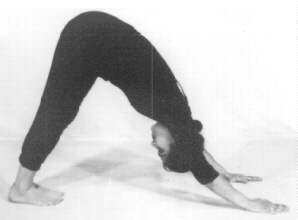|
Parvatasana - The Mountain Pose
|
by: Vasanthi Bhat and Rajiv Jaswa (vasanthi@vasanthayoga.com)
Yoga is a powerful art form with incredible healing powers.
These powers can be harnessed by anyone with a desire for self-improvement.
Stress is becoming more and more of a problem in today´s fast
paced lifestyle. It is damaging to your health and must be relieved.
There are various poses, or asanas, that can be used
to relieve stress and revitalize your tired body and mind. The
mountain pose, or Parvatasana (pur-vuht-ah-san),
is one of the easiest of these poses, and in addition has many
healing powers. Within minutes, one can be revitalized, flushing
stress out of the body. This article will focus on both mental
and physical benefits of Parvatasana the mountain pose.
Mental Benefits of Parvatasana
Parvatasana is a whole body stretch that allows good blood
circulation, creating several benefits. Better circulation to
the brain creates a revitalizing and refreshing sensation as it
reduces mental fatigue and improves memory and concentration.
This is the most important aspect of yoga. Try the Parvatasana
when you feel mentally exhausted and possibly bored and sleepy
after a long day at work or before you do your homework, if you
are a student. If you keep an optimistic outlook and focus on
the rewards of your completed work while you practice this asana
and do your work; your work as well as your attitude will improve.
Physical Benefits of Parvatasana
The physical benefits of Parvatasana are as important
as the mental benefits. This pose is also ideal for athletes,
stretching every muscle from the head to the toe. In addition
it prevents injuries by strengthening several fragile areas of
our bodies. The pose stretches calf muscles, the hamstring muscles,
the back and the forearms. This asana prevents and relieves carpal
tunnel syndrome, rheumatic stiffness, and arthritis. It can
be used for toning almost all of our body´s muscles.
When should you practice the Parvatasana
Try the Parvatasana pose in the morning, during your breaks,
in the evenings, or any free time. If you exercise regularly,
you can also use this stretch to warm up before you exercise.
Then, when you finish exercising, you can again use this to cool
down.
Technique

- Kneel and place your palms in front of you.
- Elevate yourself by pushing up with your hands and then straighten
your knees.
- Assume normal breathing while you are in the posture.
- Ideally, your heels remain in contact with the ground. If
this is not comfortable at first, leave your heels off the ground,
using only your toes for support.
- Also, remember not to bend your legs at the knees because
this does not allow the hamstring to be properly stretched.
- Remember not to strain at any time.
- For quick relaxation, try to remain in this position for about
30 seconds to 1 minute.
- However, for muscle toning and alleviating pains like arthritis,
try to stay longer, or instead repeat this two to three times.
In conclusion, the Parvatasana is a simple method of
revitalization and prevention of rheumatic stiffness and carpal
tunnel syndrome. Regardless of how busy your schedule is, you
can always spare at least a minute to get into this posture and
take a step back from your busy life.

